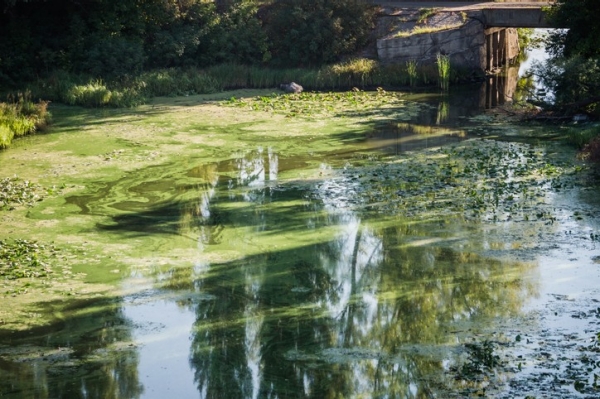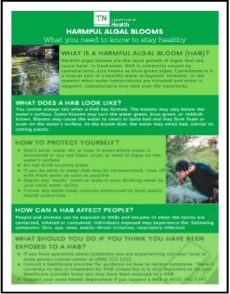Harmful Algal Blooms
Blue-green algae or cyanobacteria, are a natural part of a healthy water ecosystem. However, in the summer when the water is warm, slow-moving with low oxygen and high nutrients, these cyanobacteria may take over the waterbody.
The bloom may turn the water green, blue-green, or reddish-brown. Blooms may cause the water to smell or taste bad and may form foam or scum on the water's surface.
These bacteria can, in certain circumstances, produce cyanotoxins. The exact mechanism that cause these cyanobacteria to produce toxins is unknown.
Humans and animals exposed to these harmful algal blooms and associated cyanobacterial toxins may become ill when the toxins are contacted, inhaled or consumed. The CDC offers this Fact Sheet for HAB / Cyanotoxin exposure and additional information is available here https://www.cdc.gov/habs/
People and animals can come into contact with cyanotoxins by drinking water, swimming, or doing other recreational activities in water that has a cyanobacterial bloom. Skin or respiratory irritation can occur. Other symptoms from HAB exposure depend on the specific toxin, how the person or animal came into contact with the toxin, and for how long contact occurred.
It’s not possible to tell if a bloom is harmful just by looking at it, so people should follow precautions around algae blooms.
•Don’t swim or wade in areas where water is discolored or where you see foam, scum, or mats of algae on the water’s surface.
•Do not allow children, livestock or pets to play in or drink scummy water. Make sure children are supervised at all times when they are near water.
• If you or your pets come into contact with water that might contain cyanotoxins, rinse off with fresh water as soon as possible afterward. “ Some common cyanotoxins that are known to cause illnesses in humans and animals are microcystins, cylindrospermopsin, anatoxins, saxitoxins, nodularins, and lyngbyatoxins.
If you believe you or your pet has been exposed to cyanobacteria, please seek medical or veterinarian care immediately.
To report a suspected cyanobacterial toxin exposure or cyanobacteria (HAB) bloom:
E-mail Waterborne.Health@tn.gov, or call 615-741-7247
With funding from the CDC National Center for Emerging and Zoonotic Diseases, we are in the very early stages of participating in the CDC One Health Harmful Algal Bloom reporting system, https://www.cdc.gov/habs/ohhabs.html, for blue-green / toxic algae blooms in water and humans or animal exposures so that we may be better informed about the occurrence of these blue-green algae/ cyanobacteria in Tennessee.
With our partnering agencies at the Tennessee Department of Agriculture and the Tennessee Department of Environment and Conservation, we are developing outreach materials and response plans for these events.
The Tennessee Department of Environment and Conservation (TDEC) monitors water quality and leads a Nutrient Reduction Taskforce. A sub group of this taskforce is the Tennessee Interagency HAB Workgroup with representatives from TDEC, TDH, Tennessee Department of Agriculture, Tennessee Valley Authority, USACE, USGS, Metro (Nashville) Water, local universities and watershed groups. The HAB workgroup is assessing the occurrence of cyanotoxin, and developing capacity to respond should there be an event, and creating a Tennessee specific Harmful Algal Bloom response plan.
The US Army Corps of Engineers (USACE) and the Tennessee Valley Authority (TVA) are monitoring lakes for HAB and other potential contaminants.
https://www.cdc.gov/habs/pdf/hab-online-resource-list-2018.pdf
For more information about HAB / Cyanobacteria:
- University of Tennessee Extension Service https://extension.tennessee.edu/publications/Documents/W340.pdf
- TDA: https://www.tn.gov/agriculture/businesses/animals/animal-health/blue-green-algae.html
- TDEC Division of Water Resources: https://www.tn.gov/environment/program-areas/wr-water-resources-home.html
- TDH CEDEP Waterborne: https://www.tn.gov/health/cedep/waterborne-illness-prevention.html
- TDH One Health: https://www.tn.gov/health/cedep/one-health.html
- CDC: https://www.cdc.gov/habs/ohhabs.html
- EPA: https://www.epa.gov/cyanohabs
- NASA: https://earthdata.nasa.gov/learn/sensing-our-planet/hunting-dangerous-algae-from-space
- NOAA: https://oceanservice.noaa.gov/hazards/hab/
- USGS: https://www.usgs.gov/centers/oki-water/science/harmful-algae-blooms-habs?qt-science_center_objects=0#qt-science_center_objects

